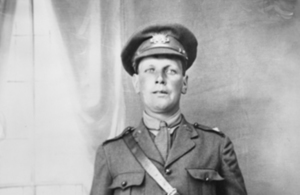WW1 Australian VC recipient Alfred Edward Gaby
The story of Australian First World War Victoria Cross recipient Alfred Edward Gaby.

Credit: Australian War Memorial A02622
66 men from Australia received the Victoria Cross, Britain’s highest award for gallantry, during the First World War. As part of the Centenary Commemorations the people of the United Kingdom marked their gratitude to those courageous men by presenting a bronze memorial plaque to their home country engraved with their names. The plaque is now displayed at the Australian War Memorial. This archive tells their stories.
Name: Alfred Edward Gaby
DOB: 25 January 1892
Place of Birth: Springfield, Tasmania, Australia
Date of Action: 8 August 1918
Place of Action: East of Villers-Bretonneux, France
Rank: Lieutenant
Regiment: 28th Battalion, Australian Imperial Force
Alfred Edward Gaby was born in Tasmania, Australia, on 25 January 1892. He worked as a farmer and labourer before joining the Australian Imperial Force in early 1916. He had previously served in the local militia (now the Australian Army Reserve) and was commissioned in 1917.
Lieutenant Gaby was awarded the Victoria Cross posthumously for his actions with the 28th Battalion on 8 August 1918, east of Villers-Bretonneux in France, during the Battle of Amiens when attacking an enemy trench. His citation explains the events:
For most conspicuous bravery and dash in attack, when on reaching a wire in front of an enemy trench, strong opposition was encountered. The advance was at once checked the enemy being in force about 40 yards beyond the wire, and commanding the gap with machine guns and rifles. Lieutenant Gaby found another gap in the wire, and, single handed, approached the strong point while machine guns and rifles were still being fired from it. Running along the parapet, still alone, and at point blank range, he emptied his revolver into the garrison, drove the crews from their guns, and compelled the surrender of 50 of the enemy with four machine guns. He then quickly reorganized his men, and led them on to his final objective, which he captured and consolidated. Three days later, during an attack, this officer again led his company with great dash to the objective. The enemy brought heavy rifle and machine gun fire to bear upon the line, but in the face of this heavy fire Lieutenant Gaby walked along his line of posts, encouraging his men to quickly consolidate. While engaged on this duty he was killed by an enemy sniper.
Lieutenant Gaby is buried at Heath Cemetery in Harbonnieres, France.